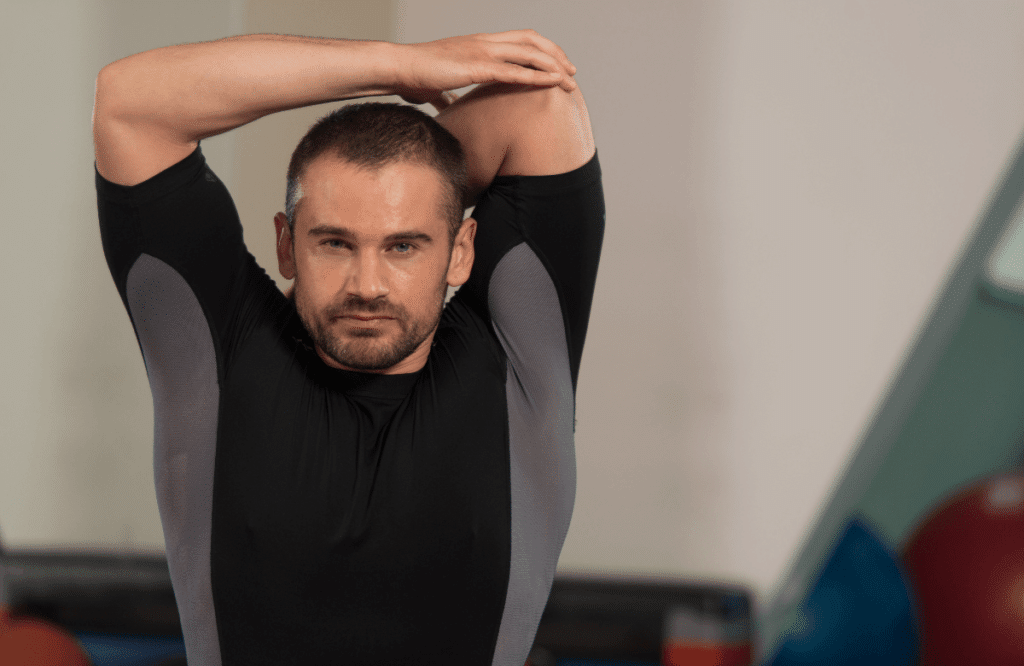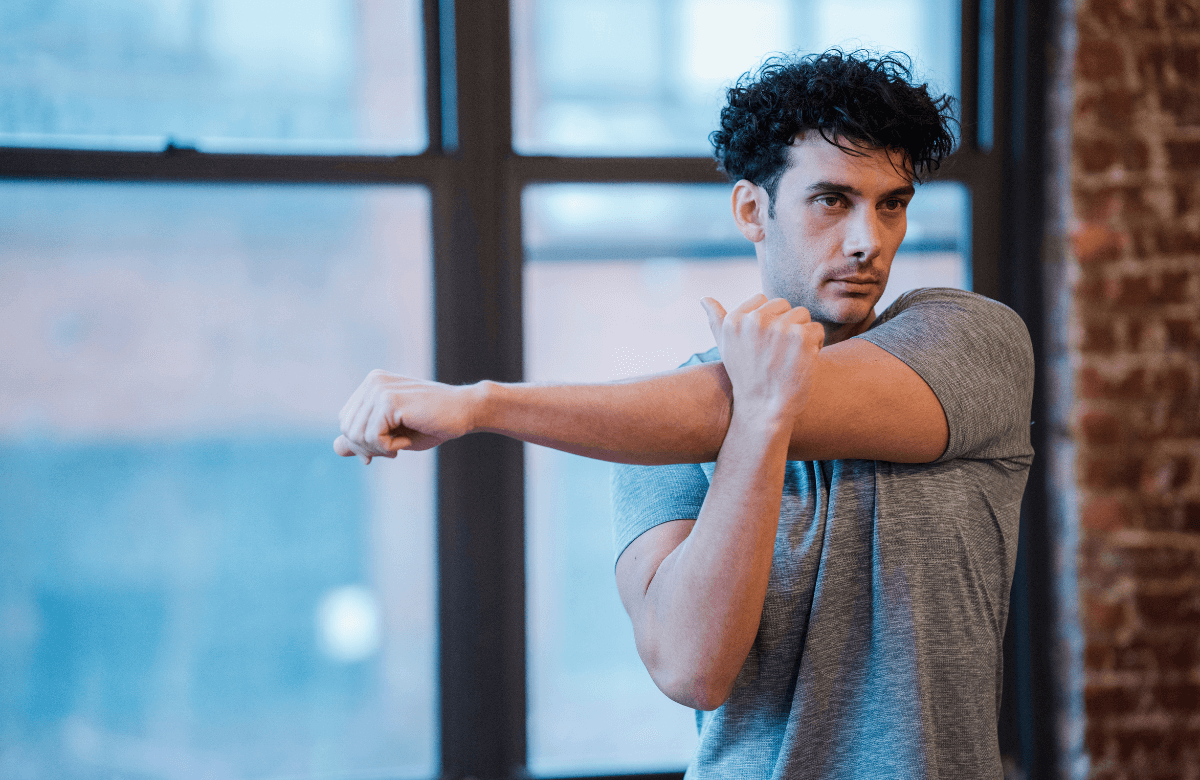We use our biceps every time we bend our elbows. As a result, these muscles get tight, sore, and overworked. Therefore, it’s necessary to know the best bicep stretches for soreness. In this article, we are going to show you how to do stretching exercises for the biceps and the brachialis muscle. Let’s get started.
Jump to:
- Bicep Anatomy and Primary Functions
- Benefits of Stretching the Biceps
- Static and Dynamic Biceps Stretches
- How to Stretch Your Biceps: 13 Best Ways to Stretch Your Biceps
- 1. Standing Bicep Stretch (Arms Behind Back)
- 2. Standing Bicep Stretch (Arm in Front of You)
- 3. Doorway Stretch
- 4. Bicep Wall Stretch
- 5. Table Bicep Stretch
- 6. Biceps Stretch With Strap
- 7. Floor Y Raises
- 8. Scap Squeeze with External Rotation
- 9. Massage Gun Bicep Release
- 10. Cable Bayesian Curl
- 11. Dumbbell Bicep Curl Lying Face-Down on an Incline Bench
- 12. Seated Incline Dumbbell Bicep Curl
- 13. Bicep Curls With a Resistance Band
- Our Tips for Biceps Stretches
- Common Mistakes
- Calories Burned
- Bicep Stretches for Soreness: FAQs
Bicep Anatomy and Primary Functions
In Latin ‘biceps’ means ‘two heads’ and ‘brachii’ means ‘arm.’ The biceps brachii has a short and a long head that eventually join together and insert just beyond the elbow joint. Both heads of the biceps muscle begin on the scapula. And both tendons of the short and the long head are covered over by the deltoid muscle.

Flexion of The Elbow Joint
When both heads of the biceps contract together, they perform flexion of the elbow joint. There’s an interesting distinction that emerges when you reach 90 degrees of flexion. If the forearm is supinated (with the palm facing up), contraction of the biceps will continue performing flexion.
But if you take it back to 90 degrees, if the forearm is pronounced, contraction of the biceps performs supination. It turns the wrist from prone to supine pulling on the radial tuberosity to twist the forearm.
Rotation of The Shoulder
If you forget about the short head for a moment, the long head of the biceps utilizes its leverage on the humerus to contribute to shoulder abduction. It also contributes to the inward rotation of the shoulder by exerting pressure on the lesser tuberosity and turning the shoulder inwards. This is also called medial rotation of the shoulder.
Adduction of The Shoulder
The short head contributes to the adduction of the shoulder. It brings the arm back toward the body by pulling on the coracoid process.
Other Muscles of The Upper Arm
Apart from the deltoid muscle, the other two close muscle relations of the biceps brachii are:
- coracobrachialis, which also originates at the coracoid process of the scapula;
- and brachialis, which lies deep on the arm.
These three muscles are all innervated by the musculocutaneous nerve. It runs down the anterior aspect of the arm between the brachialis and biceps brachii. So, the bicep brachii muscle is innervated by the musculocutaneous nerve.
Circulatory System
Arterial blood is supplied to the biceps brachii by the brachial artery. The distal tendon of the biceps can be useful for palpating the brachial pulse as the artery runs medially to the biceps brachii’s distal tendon.

Benefits of Stretching the Biceps
Here are 4 benefits of bicep stretches.
1. Prevent and Recover Injuries
A bicep stretch helps you prevent the shoulder or arm risk of injury. Also, it is great for rehabilitation. It helps with the whole healing of your shoulder and arm. So, if you’ve injured your arm, you want to be able to elongate your bicep.
2. Relieve Muscle Soreness
A bicep stretch is a scientifically proven way to speed up your recovery after a hard upper body workout. It also helps get rid of lactic acid buildup. By the way, ice and massage can help you reduce muscle pain as well.
3. Improve Arm Flexibility
Bicep stretching increases your range of motion. It’s helpful to improve forearm flexibility.
4. Prevent and Relieve Biceps Tendinitis
Some people call it bicep tendonitis. Bicipital tendonitis is an irritation of the biceps tendon that attaches the bicep muscle to the bone. You can feel your tendon like a little cord. Sometimes it’s a little uncomfortable when you push on it. Pain and weakness in the front of the shoulder are common symptoms of bicipital tendonitis.
To relieve biceps tendinitis and get that inflammation out, you want to stretch out your bicep muscle. The symptoms can also be relieved with rest and medication. In extreme cases, you may need surgery to repair the biceps tendon.
Static and Dynamic Biceps Stretches
Let’s go over static and dynamic stretches. What is better to do before your bicep workout?
What we’ve realized from a lot of literature and research is that a dynamic warm-up and dynamic stretches are always safer before exercising.
If you’re holding stretches for long periods of time before you work out, you’re more predisposed to the risk of injury because you’re separating the cross fibers of your muscle and it becomes more dangerous.
So, your warm-up should mimic the type of things you’re going to be doing in that biceps workout or whatever sport or activity you might be playing. However, after the exercise, it’s better to do static stretching.

How to Stretch Your Biceps: 13 Best Ways to Stretch Your Biceps
Here are the 13 best bicep stretches for soreness.
1. Standing Bicep Stretch (Arms Behind Back)
One way to do bicep and brachialis stretches is to interlace your fingers behind your back. You’re going to turn your palms out and lift them as high as you can. You want to go to slight discomfort with nerve pain.
You’re going to hold this gentle stretch for about 20 seconds, come back up, and do that three times. You’re going to feel that the more you lift your arms, the greater the stretch.
2. Standing Bicep Stretch (Arm in Front of You)
This is another excellent stretch. You are going to simply place your arm in front of you at about a 45-degree angle. You’re going to turn your palm out. You want to put pressure on your hand with the other hand increasing the pressure as much as you can tolerate. Hold this stretch for about 20-30 seconds. Then you’re going to switch arms so you get the benefit on both sides.
3. Doorway Stretch
What you want to do is stand nice and tall with your shoulders back and have both hands up against the door. Act like you’re stepping through it until you feel a stretch. You want to feel a stretch in your biceps and chest. Hold it for 30-45 seconds. Do it twice.
4. Bicep Wall Stretch
You want to have your palm facing forward, put it either on the doorway or something solid like the chair and straighten out your arm.
If you stand facing the wall, all you want to do is lengthen your arm and push into the wall. You don’t want to be bound up or have a bent elbow or a bent shoulder. Having that nice and steady you’re going to rotate out and away from that wall. As you rotate away, that demands a deeper stretch in your biceps.
You’re going to hold that stretch at least for 10 seconds. Try building up to a minute. It’s a nice and comfortable stretch that can continue to go on for two minutes. If you could just stretch your biceps for two minutes, that’s fantastic.
This is going to be a good deep stretch and it’s helping you especially if you’ve been in the flex position too long. This is going to help unravel that and balance your elbow up for better health long term.
Go ahead and do that for up to two minutes progressively getting there so that it’s comfortable for up to two minutes. And do some time on the other arm as well even though that’s not the injured arm.
5. Table Bicep Stretch
The exercise should be performed in a standing position. You’re going to place your palm flat on a table or a bench. Your palm is facing up. Pushing forward helps a little bit more. It gives you a good stretch through your biceps muscles.
Hold it for about 30 seconds and then come back. But don’t push too hard. Just push to where you feel a good stretch. Do that 3 times.
If that one’s not comfortable, or you want a different way to do it, you can get a chair and put your palm down on it. And then the same thing, push your shoulder forward or lean forward. And you’re going to get that stretch through your biceps muscle and the bicep tendon. Hold that for about 30 seconds, come back up, and do that 3 times.
6. Biceps Stretch With Strap
For the next exercise, you’re going to use a resistance band. This is going to be the internal and external rotation of the shoulder.
You want to anchor your band into something like a doorway or have some person hold it off to the side. You can tie it up onto something sturdy. But make sure it’s tight so it doesn’t come back and pop you in the head.
Keep your elbow by your side. Some people have a hard time with this, so you are going to roll up a towel and put it right underneath, then squeeze it in there. If it falls down, then you know your elbow’s coming away from the side.
Keep the thumb up, keep your wrist in a neutral position and your elbow at about a 90-degree angle. And just nice, slow, and controlled come in towards your stomach and then control it coming back out. You don’t have to go all the way back out, just come to about that parallel to your other arm.
Just start off with 10-15 reps. If they become easy, you get to 20-25, then you can go to a more resistive band.
You are going to switch sides. Your hand is going in towards your stomach, elbow’s still by your side, still at about that 90-degree angle, thumb up, wrist in a neutral position.
7. Floor Y Raises
With your arms fully extended, lie on your stomach. Your thumbs are pointing up. You want to raise your arms off the floor as far as you can. You’re literally making the shape of the letter “Y”. Hold that for about 30 seconds and then come back. Repeat.
Exhale when raising your arms, and inhale when you come down. Make sure you keep your arms straight during this exercise.
8. Scap Squeeze with External Rotation
Elbows are bent at around 90 degrees. Turn your palms up. Row your arms back. Then rotate shoulders externally, keeping elbows tucked in. Focus on pinching shoulder blades together and down. Don’t shrug your shoulders.
9. Massage Gun Bicep Release
One of the effective ways to release the bicep muscle tissue is by using a massage gun. It’s an amazing device to help you manage your bicep pain and find relief.
Firstly, pick your attachment. It allows you to personalize your usage for your own needs. Turn on the massage gun to the low setting. Make sure you set the treatment speed before applying it to your body. Determine which grip will feel most natural for you to use while treating your bicep.
Start with a lighter gentle pressure and work it from the lower part of the bicep up to your shoulder. Repeat as desired for no longer than 30 seconds.
10. Cable Bayesian Curl
You want to have your back to the cable machine and keep your elbows at your sides as you curl up. You want to squeeze your biceps at the top of the arm movements.
Make sure you are not using momentum and you are staying upright while retracting your scapula and keeping your chest elevated. You want to keep the tension on your biceps. To stretch your bicep better, fully lock out at the bottom for a few seconds.
11. Dumbbell Bicep Curl Lying Face-Down on an Incline Bench
This exercise is great for stretching out the head of the bicep. You’re going to use an incline bench. Lay down on the bench allowing your biceps to stretch all the way down. Make sure you use light weights.
You want to curl up and allow your arms to go all the way down stretching the heads of the biceps. You’re breathing out as you flex your arm up. Try to keep your arm straight and controlled.
12. Seated Incline Dumbbell Bicep Curl
The next exercise is called bicep curls. Adjust the incline bench to around 45 degrees. Place the dumbbells in front. Then with your thumbs wrapped around, grab the dumbbells in the palms of your hands. Lean back onto the bench.
You’re going to have your elbow against your side, and you’re just going to bring the dumbbells up and then slowly down. You want each curl to be nice and slow.
Pause at the bottom for a few seconds to stretch your biceps fully. Make sure you use light weights and do the exercise without causing any harm to your biceps. You’re going to do 2-3 sets.
13. Bicep Curls With a Resistance Band
The last one is going to be a bicep curl. Sit on a chair and step on the resistance band. Make sure you’re stepping on it hard so it doesn’t come back and pop you. Keep your elbow by your side. And then just slowly pull all the way up towards your arm. Get a full motion and come all the way back down.
You can stand up doing it and get that full motion all the way through. Just nice and controlled, squeeze it there, hold it a little hold, and then slowly come back down. Start off with 10-15 reps and work your way up from there.
Our Tips for Biceps Stretches
1. Motions
Bicep stretching requires the opposite motions to biceps functions. They involve rotating your wrists and extending your arm.
2. Breathing Pattern
It’s important to maintain the proper breathing pattern during bicep stretches to get more range of motion. It also relaxes the body, increases circulation, and helps get rid of lactic acid buildup.
Firstly, get control of the breath. Extend the exhales longer and longer as you go. Don’t worry too much about the inhales. If you can exhale longer, your body will automatically inhale.
Ideally, you’re going to try to breathe in and out through your nose. You might start with the mouth but the ultimate goal is to close the mouth and bring the inhale and the exhale through the nose.
The reason that you want to control and slow your breathing down is that you need to show your body that you can stretch your biceps and that even though it’s uncomfortable you’re going to stay in the position. If you can gain control of your breath, then you can calm yourself and allow yourself to stay in the best bicep stretches longer.
3. Duration and Intensity
What is the appropriate amount of time to hold bicep stretches? According to current concepts in muscle stretching, it depends on different factors:

1. What is your set point?
If you want to get more flexible, you are going to need to hold it for longer than 30 seconds.
2. How does your body react to bicep stretching?
If you’re going to do a bicep stretch and it feels intense and horrible, you probably want to reduce the intensity and take some breaths so your body has some time to acclimate to what’s going on. If you go into the bicep stretch and it feels like that’s a good challenge, you can hang out there longer.
3. Are you a beginner?
If you’re a beginner, we certainly wouldn’t recommend that you start holding bicep stretches for three or more minutes. That’s something you can do only as you get used to understanding your body’s responses and sensations to stretching. So, for beginners, 30 seconds are a great starting point.
Common Mistakes
1. Too Long Breaks
The problem with this is that what counts is consecutive time otherwise it has no effect. For example, three times for 20 seconds doesn’t have the same effect as one minute in one go. So, if you have the time do the stretching in one go, use it to elongate the structure more and more.
2. Not Enough
Most people don’t stretch long enough. The point of stretching is getting the structure to elongate. That’s what stretching is good for. But what exactly has to elongate? The muscle is made of muscle fibers and fascia.
The most modern research on fascia tells us that the network of fascia that needs to be elongated only starts to flow after half a minute. That means it takes more than 30 seconds before you’ll have this palpable effect. That’s why you need to stretch for at least 30 seconds.
3. Intensity
The last of the most common mistakes is intensity. How strong should a bicep stretch be?
Pain is a warning signal. If you start feeling pain, that is something we call below-the-threshold stretching. It has some small effects but by far not enough if you want to make progress. You have to be aware of the pain but not afraid of it.

Pain starts at a low level as if it were no pain at all. And then we would recommend to turn up the pain dial just a bit to where it hurts a bit and then to a point where it hurts a lot. This upper-end limit is as important as the lower-end. That’s the point where you start to feel a pain intensity that makes you counteract muscle guard.
Start a stretch and increase its intensity. You should hold still when you breathe in and lean more into the stretch when you breathe out. Because whenever you exhale, your brain switches to relaxation. That makes it easier for you to increase the stretch than if you do that independently of your breathing.
Calories Burned
The exact amount of calories that you burn depends on different factors such as your age, the weight of your body, and the duration of bicep stretches. Generally, bicep stretching burns around 13 calories per 5 minutes. For accurate results, use the calories burned stretching calculator.
Bicep Stretches for Soreness: FAQs
What are the best stretches for sore biceps?
Here are the best bicep stretches for soreness: door stretch, wall stretch, table bicep stretch, and bicep stretch with a strap.
Why is my bicep muscle so tight?
Your bicep muscles might be tight and feel sore because they are overworked or injured. It’s very common to have two different kinds of bicep injuries: A tendonitis. That’s when the tendon of the biceps gets inflamed;
An impingement. That’s when it gets pinched in the shoulder.
Both are caused by overuse when you bring your shoulder up with a heavy weight repetitively.














